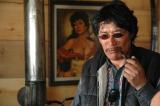Click on links to download complete PDF
"From an international filmmaking perspective, the pressure is immense. If Atanarjuat represented a leap forward both in fiction and filmmaking, Rasmussen will confirm the genius of its co-creators or send them back into obscurity. But I can't help feeling that Kunuk, the hunter who happens to be a filmmaker, will not care or even notice one way or another. He's been doing his thing for twenty years; a bad notice isn't going to stop him any more than some bad weather would keep him from hunting." - Denis Seguin, The Walrus, 'The Hunter Who Happens to Make Movies: The Art of Zacharias Kunuk.'
The Walrus - Denis Seguin June 2006
"Inuit people are storytellers. Four thousand years we have been passing stories to our youth. We saw other films being made about the north where you could see your woman's seal oil lamp turned the wrong way around and the production doesn't really care. One time I saw our seal oil lamp was a torch like the big Olympic flame. [laughter] It is important we tell our stories from our Inuit point of view." Zacharias Kunuk, 2002 Spry Memorial Lecture, Simon Fraser University, 'The Public Art of Inuit Storytelling.'
2002 Spry Memorial Lecture - Zacharias Kunuk 021125
"'Shamanism was here, and it's going to be here, that's what my elders tell me. After Atanarjuat, the elders started to talk about shamanism more. With this film, because their families are in this community, people learned about their namesakes. We live by namesakes. When I was born, I was given five names, but the government couldn't pronounce them so we were given tags and family names.'" Interview with Zacharias Kunuk by Mari Sasano, Edmonton Journal
Edmonton Journal - Interview with Zacharias Kunuk 061006
"I don't know the men who made this film, but I can imagine them. I see them as men who come into the world loaded with their own cultural capital, free of the sense of victimization that cripples our communities into a crazy kind of paralysis. I am awed and inspired by the filmmakers who can take a very European document like Rasmussen's journals and create a specifically Inuit film from them that also serves every Indigenous community as it does. I am further awed and inspired that it shows non-Indigenous people exactly how the madness in our world came about. The next time someone asks, 'What happened, why are Aboriginal people so violent?' I will simply say, 'Watch The Journals of Knud Rasmussen.'" Lee Maracle, Mapping Our Way Through History: Reflections on Knud Rasmussen's Journals
Mapping Our Way - Lee Maracle 2008
"You had to become Christian. I remember the day I was baptized in 1963, when I was six years old. We dog-teamed into this community and we were in the church. My two brothers and sister and I were sitting on a bench, the stove warming up a tea pot that was going to be used to baptize us. My parents are very religious. Probably I learned the idea of good and evil from them, black and white. The day I was baptized the person who was going to baptize me was wearing a black robe. I thought, "It's the devil himself!" I was so scared that my mother had to take me out. Maybe if he had been wearing a white robe it would have been okay, but everything was black." Zacharias Kunuk Speaks with Joysanne Sidimus
Zacharias Kunuk Speaks with Joysanne Sidimus 2004
"As video artists in the first decades of a medium whose distinct character finally reveals itself in high-definition, we have responsibilities to a second, universal audience of which Inuit are a part. We explore changes in storytelling made possible by unique properties video brings to narrative representation. In particular, digital transparency allows visualizing Time in three dimensions - duration, quality and simultaneity – with an illusion of actuality that lends human emotions new urgency. As agents in our own lives, and spectators of others, we recognize authentic meaning only in emotions experienced in ‘real time’; that is, not the fake and fractured time of conventional filmmaking but the three-dimensional time of real life." - Norman Cohn, When your work speaks for itself, don't interrupt
When your work - Norman Cohn 2008
"In January 2008, Isuma Publishing released a new book, The Journals of Knud Rasmussen: A Sense of Memory and High-definition Inuit Storytelling. This book includes the complete original screenplay in English and Inuktitut of The Journals, Isuma's second feature film in The Fast Runner Trilogy after Atanarjuat The Fast Runner, and 25 pieces of writing reflecting on themes of memory, history and Isuma's approach to filmmaking as Inuit storytelling. Edited by Gillian Robinson, writers include Lee Maracle, Floyd Favel, Hugh Brody, Alberto Manguel, Alootook Ipillee and others." - Selected Writings




